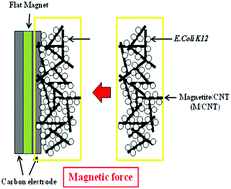Direct electron transfer in E. coli catalyzed MFC with a magnetite/MWCNT modified anode
Abstract
Although microbial

* Corresponding authors
a Specialized Graduate School of Hydrogen and Fuel cell Engineering, Chonbuk National University, Jeonju 561-756, Republic of Korea
b Department of Energy Storage Conversion Engineering, Chonbuk National University, Jeonju 561-756, Republic of Korea
c
School of Chemical Engineering and Technology, Chonbuk National University, Jeonju 561-756, Republic of Korea
E-mail:
nahmks@jbnu.ac.kr
Fax: +82 63 270 3908
Tel: +82 63 270 2311
Although microbial

 Please wait while we load your content...
Something went wrong. Try again?
Please wait while we load your content...
Something went wrong. Try again?
I. H. Park, Y. H. Heo, P. Kim and K. S. Nahm, RSC Adv., 2013, 3, 16665 DOI: 10.1039/C3RA42257G
To request permission to reproduce material from this article, please go to the Copyright Clearance Center request page.
If you are an author contributing to an RSC publication, you do not need to request permission provided correct acknowledgement is given.
If you are the author of this article, you do not need to request permission to reproduce figures and diagrams provided correct acknowledgement is given. If you want to reproduce the whole article in a third-party publication (excluding your thesis/dissertation for which permission is not required) please go to the Copyright Clearance Center request page.
Read more about how to correctly acknowledge RSC content.
 Fetching data from CrossRef.
Fetching data from CrossRef.
This may take some time to load.
Loading related content
